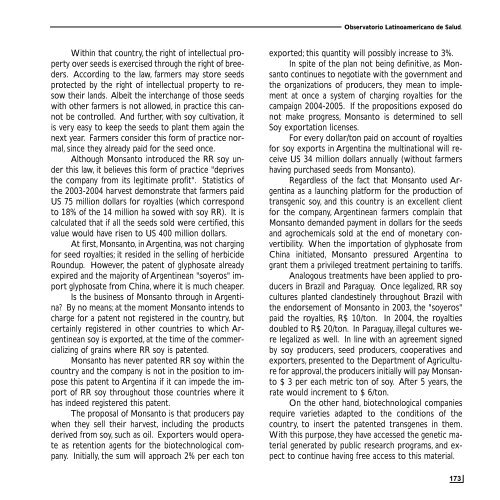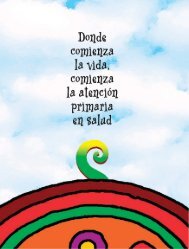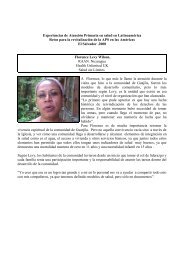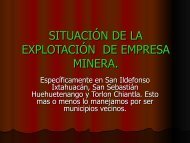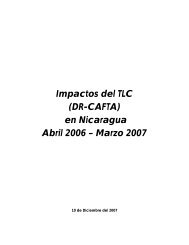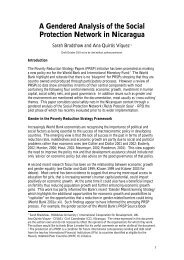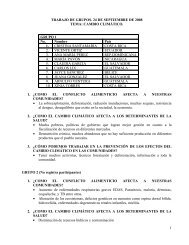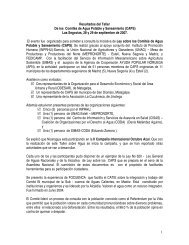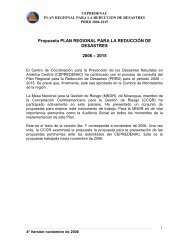Download - CISAS | Centro de Información y Servicios de AsesorÃa ...
Download - CISAS | Centro de Información y Servicios de AsesorÃa ...
Download - CISAS | Centro de Información y Servicios de AsesorÃa ...
You also want an ePaper? Increase the reach of your titles
YUMPU automatically turns print PDFs into web optimized ePapers that Google loves.
Observatorio Latinoamericano <strong>de</strong> Salud.Within that country, the right of intellectual propertyover seeds is exercised through the right of bree<strong>de</strong>rs.According to the law, farmers may store seedsprotected by the right of intellectual property to resowtheir lands. Albeit the interchange of those seedswith other farmers is not allowed, in practice this cannotbe controlled. And further, with soy cultivation, itis very easy to keep the seeds to plant them again thenext year. Farmers consi<strong>de</strong>r this form of practice normal,since they already paid for the seed once.Although Monsanto introduced the RR soy un<strong>de</strong>rthis law, it believes this form of practice "<strong>de</strong>privesthe company from its legitimate profit". Statistics ofthe 2003-2004 harvest <strong>de</strong>monstrate that farmers paidUS 75 million dollars for royalties (which correspondto 18% of the 14 million ha sowed with soy RR). It iscalculated that if all the seeds sold were certified, thisvalue would have risen to US 400 million dollars.At first, Monsanto, in Argentina, was not chargingfor seed royalties; it resi<strong>de</strong>d in the selling of herbici<strong>de</strong>Roundup. However, the patent of glyphosate alreadyexpired and the majority of Argentinean "soyeros" importglyphosate from China, where it is much cheaper.Is the business of Monsanto through in Argentina?By no means; at the moment Monsanto intends tocharge for a patent not registered in the country, butcertainly registered in other countries to which Argentineansoy is exported, at the time of the commercializingof grains where RR soy is patented.Monsanto has never patented RR soy within thecountry and the company is not in the position to imposethis patent to Argentina if it can impe<strong>de</strong> the importof RR soy throughout those countries where ithas in<strong>de</strong>ed registered this patent.The proposal of Monsanto is that producers paywhen they sell their harvest, including the products<strong>de</strong>rived from soy, such as oil. Exporters would operateas retention agents for the biotechnological company.Initially, the sum will approach 2% per each tonexported; this quantity will possibly increase to 3%.In spite of the plan not being <strong>de</strong>finitive, as Monsantocontinues to negotiate with the government andthe organizations of producers, they mean to implementat once a system of charging royalties for thecampaign 2004-2005. If the propositions exposed donot make progress, Monsanto is <strong>de</strong>termined to sellSoy exportation licenses.For every dollar/ton paid on account of royaltiesfor soy exports in Argentina the multinational will receiveUS 34 million dollars annually (without farmershaving purchased seeds from Monsanto).Regardless of the fact that Monsanto used Argentinaas a launching platform for the production oftransgenic soy, and this country is an excellent clientfor the company, Argentinean farmers complain thatMonsanto <strong>de</strong>man<strong>de</strong>d payment in dollars for the seedsand agrochemicals sold at the end of monetary convertibility.When the importation of glyphosate fromChina initiated, Monsanto pressured Argentina togrant them a privileged treatment pertaining to tariffs.Analogous treatments have been applied to producersin Brazil and Paraguay. Once legalized, RR soycultures planted clan<strong>de</strong>stinely throughout Brazil withthe endorsement of Monsanto in 2003, the "soyeros"paid the royalties, R$ 10/ton. In 2004, the royaltiesdoubled to R$ 20/ton. In Paraguay, illegal cultures werelegalized as well. In line with an agreement signedby soy producers, seed producers, cooperatives an<strong>de</strong>xporters, presented to the Department of Agriculturefor approval, the producers initially will pay Monsanto$ 3 per each metric ton of soy. After 5 years, therate would increment to $ 6/ton.On the other hand, biotechnological companiesrequire varieties adapted to the conditions of thecountry, to insert the patented transgenes in them.With this purpose, they have accessed the genetic materialgenerated by public research programs, and expectto continue having free access to this material.173


